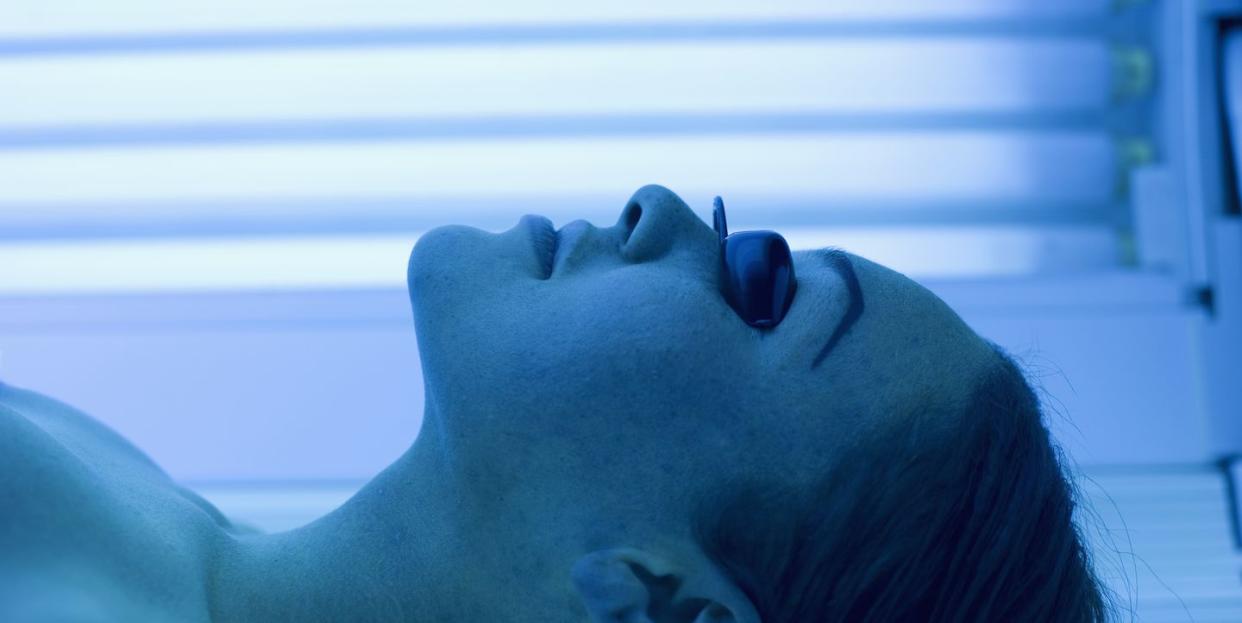Is TikTok’s #sunbedaddiction the most dangerous trend on social media today?

TikTok beauty trends can span the good (heatless styling), the bad (sunscreen contouring) and the ugly (scalp popping), but one that’s positively dangerous is the promotion of #sunbedaddiction – videos tagged as such currently claiming 28.8 million views on the platform. While many a millennial and older might have left their tanning habit in the past – learning the skin cancer risks that come with sunbed use – it seems a new generation of tanners are unaware, or simply don’t care.
A study by Melanoma Focus found that 42 per cent of 18- to 25-year-olds reported using a sunbed at least once, the highest of any age bracket. Elsewhere, having recently interviewed 1,000 women across the UK, the self-tan brand Vita Liberata uncovered more shocking stats relating to sunbed use, with two out of three women saying that they have used sunbeds, and one in three adding that they will continue to do so – despite 91 per cent being aware of the health risks. Only 39 per cent said they would stop using sunbeds with the knowledge that it’s considered more dangerous than smoking (given that a higher number of people get skin cancer from sunbeds than lung cancer from cigarettes).
An issue for almost half interviewed (48 per cent) is that sun bed use can be addictive – which is scientifically proven. Published research conducted using functional magnetic resonance imaging (fMRI) has shown that UV exposure, whether from the sun or tanning beds, can activate brain regions associated with reward and addiction, suggesting that tanning behaviour may trigger similar neural pathways as addictive substances. Meanwhile, other studies have found that individuals who engage in excessive tanning behaviour often exhibit symptoms like those seen in substance-related disorders, such as tolerance increase and withdrawal distress.
“There should be more education around the dangers of sunbeds, and really they should be banned in the UK,” says Dr Paul Banwell, who is a skin cancer expert and a founding member of the Safer Cosmetic Surgery Group and the founder of The Melanoma and Skin Cancer Unit (MASCU) in East Grinstead. “More education around the subject of sun safety is essential, especially for younger people,” he tells Harper’s Bazaar.
With this in mind, we asked Dr Banwell to highlight everything you need to know about sunbed use and its link to skin cancer, below.
The problem with sunbeds
Sunbeds have proven risks with respect to skin cancer formation, Dr Banwell confirms: “They are known to significantly increase your risk of developing most forms of skin cancer including melanoma.”
“We know that skin cancer is caused by exposure to the 'solar constant' – the combination of ultraviolet radiation (UV-A and UV-B), infrared (IR), and visible light from the sun,” he explains. “Intense UV exposure via sunbed use also dramatically increases risk of skin cancer formation (up to 70 per cent) and therefore avoidance of sunbeds at all costs is highly recommended.”
“Any previous history of sunbed use (even once) puts skin cancer specialists like myself on red alert. I have noticed an increase in patients coming to me for mole removal and skin cancer treatment who have previously used sunbeds.”
Sunbeds vs the sun
There is a big misconception around sunbeds, Dr Banwell says, with marketing making many believe that sunbed use is safer than sunlight tanning. “It’s not: sunbeds emit greater doses of UV rays than even the midday sun and UV rays cause DNA damage in your skin, which then can lead to skin cancer.”
“There is a grave misconception that it is important to use sunbeds in the winter to ‘build’ a tan throughout the colder months,” he adds. “This exposes the public to high-strength UV rays during months when they wouldn’t have typically had them.”
The ‘benefits’ of sunbeds
Some will claim that sunbeds help with certain skin conditions, such as acne and psoriasis. However, “while UV exposure in moderation can sometimes help calm inflammation, sunbeds may actually exacerbate acne scars as the UV rays have the potential to harm collagen and elastin fibres in the skin,” Dr Banwell explains.
With psoriasis and dry skin, experts also do not recommend sunbed use. “Sunbeds emit UVA light, which alone will not help with the symptoms of psoriasis as it needs the addition of a chemical called psoralen.”
“Sunbeds are sometimes marketed as a way of getting a ‘safer tan’, or a way to avoid burning while tanning in the sun, but it is a complete fallacy that sunbeds can provide a ‘protective tan’,” he says. “Moreover, sunbeds can also promote premature ageing, accelerated wrinkling of the skin, and eye problems.”
He confirms: “There is no such thing as safe tanning from UV radiation and using a sunbed before sunbathing to achieve a ‘base tan’ will not prevent you from getting sunburn.”
Sunbeds and (the lack of) legislation
In Australia, Brazil and Iran, sunbeds are already banned, while other countries have introduced tougher restrictions on sunbed use. “We could save thousands of lives if a ban was enforced in the UK, too,” Dr Banwell feels.
“There should be more education around the dangers of sunbeds, and really they should be banned in the UK.”
Alyson Hogg, founder of Vita Liberata (which is donating 50 per cent of net sales on its website in May to the British Skin Foundation), agrees, adding that, at the very least, sunbeds should come with clear cautions.
“Warnings like ‘sunbeds are addictive’ and ‘sunbed radiation can cause cancer’ should be present and clear before anyone steps onto a sunbed,” she feels. “We also need firmer regulation on sunbed shops to ensure correct checks are made on proof of age, medical history and that time and frequency of exposure is limited. Healthcare professionals should also be communicating the dangers and risks associated with sunbeds, like they do with smoking. This will save lives.” Here’s seriously hoping.
You Might Also Like

 Yahoo Lifestyle
Yahoo Lifestyle 
